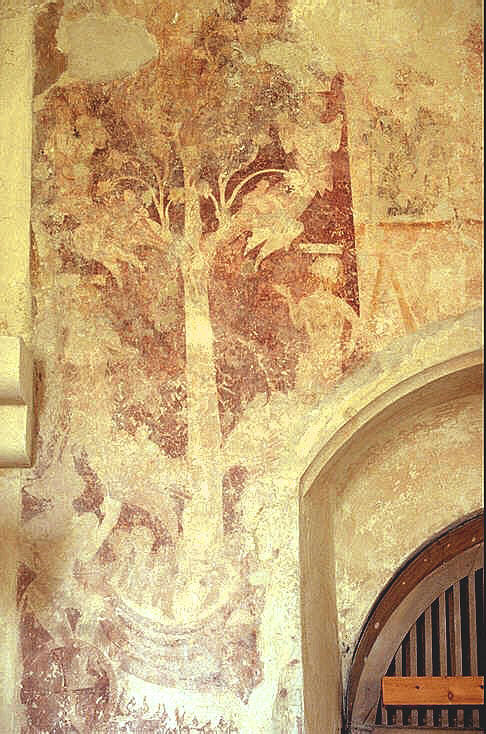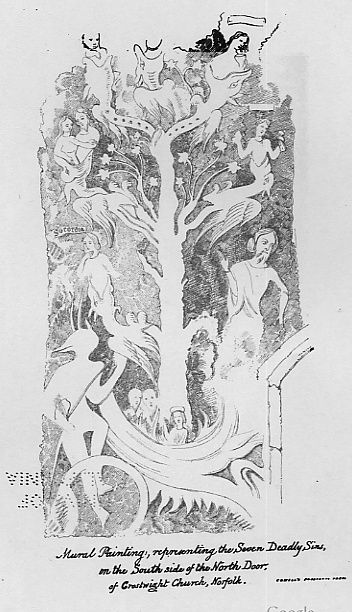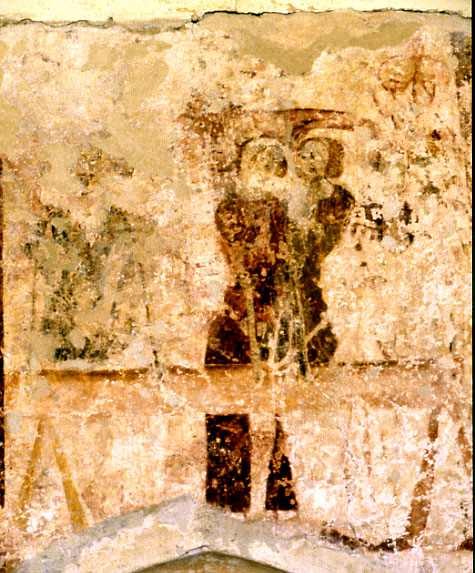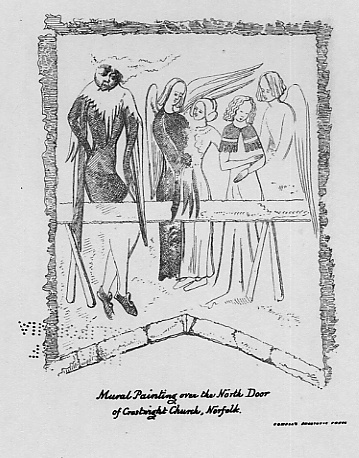Crostwight, Norfolk (†Norwich) C.14/15
The Seven Deadly Sins

At the left, a very fine example of a Tree-Diagram version of the subject, close in date and similar in conception to Hoxne but more refined in design and execution. The Tree is placed centrally and is very well painted, with naturalistic branches and leaves , At the end of the branches, and now much obscured, are the various Sins. This drawing by Mrs Gunn, the wife of a former vicar of Crostwight, and unearthed thanks to Google Books, shows some of the now obscured detail.

The branches of the tree end in dragon’s mouths as so often, and that at the top centre in the drawing probably represented Pride (Superbia), flanked on the left by an unidentifiable sin and on the right by Gluttony (Gula), a figure holding a cup.
Further down on the left is Lust (Luxuria), fairly unmistakeable with a male and female figure embracing. Opposite on the right is Avarice (Avaritia) with a figure clutching a money-bag. The lowest branch on the left, a figure with chin propped on hand, has kept its identifying label, which still reads ‘Soccordia’ (Sloth), and I think the large, bearded figure at the lower right is probably Envy (Invidia), since the Norfolk Archeology article makes mention of a green tunic.
Also much clearer in Mrs Gunn’s drawing (which I think is probably a trustworthy enough copy) is the larger dragon’s mouth representing Hell, from which the Tree grows, and three figures inside, the central one in a pillbox hat.

A Consecration Cross in a circle (there are several more in the church) has been superimposed at the bottom left, over Satan’s feet. The meaning of the painting is fairly clear as it stands – the sins grow ultimately from Satan’s domain in Hell, where nothing except evil can be generated, but there is more.

Above the north door beside the painting is a mysterious subject (shown in the photograph to the right) is almost certainly related to the Seven Deadly Sins. A trestle table is placed horizontally, with a couple apparently embracing standing behind it. According to EW Tristram² there were once three couples here, along with a large demon, but a 19th century drawing in the church shows figures, probably angels, standing beside the human figures while a disgruntled-looking devil stands nearby. So this may have been a Psychomachia, very different in kind from that at Claverley, but perhaps broadly similar to that at Swanbourne in Buckinghamshire, showing the contrasting condition of souls at death.
The second drawing by Mrs Gunn confirms the Psychomachia aspect of the Crostwight painting. This is how the painting looked in Victorian times, with a large devil at the left so elaborately clad that I think he must represent Pride in its most obvious manifestation as a delight in personal adornment. Two angels stand beside two well-dressed young people, both girls, I think, and they seem to be shown in the process of leading them gently away from temptation.
Crostwight is one of the most interesting painted churches in Norfolk, obscure as some of the subjects now are. The very fine Passion Cycle is also on this site.
† in page heading = Diocese